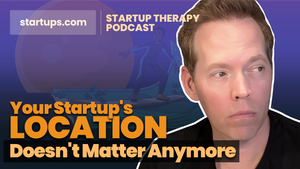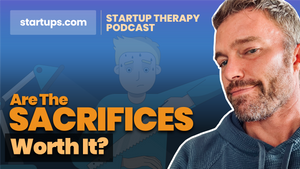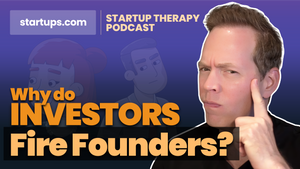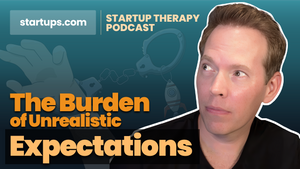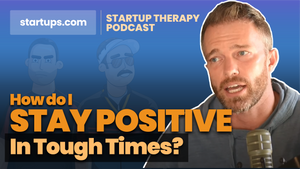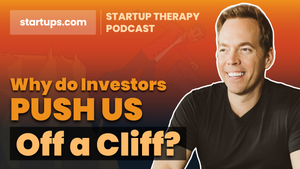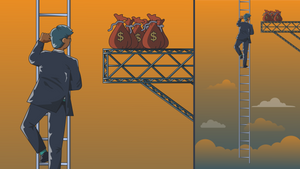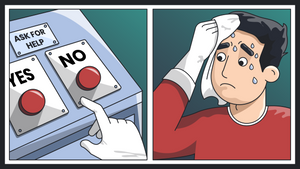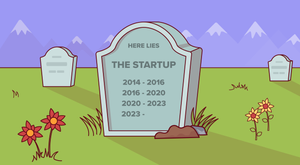Find this helpful?
This is just a small sample! Register to unlock our in-depth courses, hundreds of video courses, and a library of playbooks and articles to grow your startup fast. Let us Let us show you!
Submission confirms agreement to our Terms of Service and Privacy Policy.
Already a member? Login
AI Generated Transcript
Ryan Rutan: Welcome back to another episode of the start up therapy podcast. This is Ryan Rotan joined as always by my friend and partner and CEO of start ups dot com. Will Schroeder, will we build start ups for lots and lots of reasons as founders and we follow a lot, a lot of different information in terms of the signals that we use to decide what to build. But we wanna unpack one today that tends to be a little dangerous, which is letting your investors start to drive the road map and basically treating them like they're your customer. Where does this happen? Why does this happen? Let's, let's beat it up,
Wil Schroter: man. Well, it's happened a lot right now because uh nobody's buying and investors, the only people putting the money in. And then we get to this thing. I think it starts early. I think it starts in the, the, the very, very formative stages. We start raising money for the first time and you right, you and I hear this all the time. People are like, oh, what will investors want to hear? And I'm like, well, hold on a second. It's, it's good that you're thinking about your audience. But at the same time, at the same time, you also have to realize the investors are a mechanism to get to your actual customers. They're not your actual customers. So when an investor says, well, you need to be doing XYZ. Cool. Is that what your customers want or is that what an investor wants? We start very early with this concept that we should optimize for what investors want. And at first it seems like not a big deal. It seems the price of admission, right? You know, forget your first cash and I get that we're very vulnerable with that. However, as time goes by, as more time goes by where we start needing more and more capital, the classic thing that, that's, that's blown up on everybody right now. When we're recording this episode, I was like time stamp it. What is this August of 2023? We are in hopefully the lowest ass end of the global funding winter. Right. And right now, no one can get funded, which means all of those companies that were given money before it. Investors told to grow as fast as they can. Revenue, be damned. We're all paying for it and guess who they're trying to go to, to fill in the blanks to be able to get their revenue right now. Yep. Right back to investors. Yep. That's where the challenge ends. We get on this, this treadmill and we can't get off. Yeah, which
Ryan Rutan: look like you said, it's, it's a bit of a necessary evil in the beginning. You gotta tell people to some degree what they want to hear. You gotta be doing something that seems appealing to them. And I think we see this come in two flavors. We've talked about this before. And so I just want to draw the distinction between two types of investor feedback. One tends to be before they invest. The other is after the one before they invest is, well, we might be interested if you do XY or Z, right? We've talked about this, this is a load of shit. This is just a nice way of saying go away. We don't want to talk to you, but we don't tell you, we want to talk to you, right? So the the other version of this is, you know, post funding where they start to, you've made some promises or you've, you've said some things, they've said some stuff back and it's they, they start to like take the reins a little bit in ways that are are less than healthy and start to drive that road map and define it. So just wanna make that subtle distinction. But yeah, in the absence like right now where we are, you know, that especially when capital is dried up. I think that two things happen when we've got an economic crisis, booming again, booming. I don't know if it's the economic crisis is boom. I don't, I don't. Anyways, feels
Wil Schroter: pretty booming as a
Ryan Rutan: crisis, there's a crisis. So people aren't buying. Right. So, you know, it's not a great time to be figuring out how to sell something. And so if the cash isn't there for that, we got to go to investors. Well, we're also in a funding crisis in that regard and I think this makes people even more susceptible to this. So they're even more likely to say, look, I will wear whatever hat I will jump through whatever flaming ring I will do whatever it takes to get to that capital. And I think again, there's a point in time where that actually makes sense and you may have to do that, but at some point, we have to transition back from investor as customer to customer as customer otherwise just in the business of raising and spending other people's money, which does have a top limit.
Wil Schroter: Yeah, but hold, but that's exactly what we're talking about. I don't think founders get that right. And I don't think founders understand that like once you start raising capital and it's, you know, necessary part of a lot of businesses. But once you start raising capital, you are now in the capital, raising business. Here's how people go into it. Most start ups go into it. Almost all founders. I'm trying to think of one that didn't, I, I can't think a single case. We go into it and we start off with this, I'll raise capital. It's a pain in the ass. It's a little painful because I have to, you know, give up equity and things like that. But I do it because it's a means to an end and that end is very important to me. So here's what will happen. What will happen is I'll raise some capital and then I'll never need it again. Or I'll, you know, when I need it again, it, it'll be easier because I've already raised it whatever. Rosier days ahead. That's, that's how I start. What I fail to understand is that once I start drawing down on money that I haven't made, the only way to keep going is to draw down on more money that I haven't made. And, and again, the hope the plan so to speak, that never materializes is that I'll raise, I'll use it, I'll create a profitable business and I won't need to raise again. Happens. Almost never. We all keep hearing it. So let's talk about that. But once we start on this track, how could we possibly get off of it if not for customer rep? Which is our problem, right.
Ryan Rutan: Yeah, I mean, there isn't really another version, right? I mean, the, the only other thing would be that you've somehow gotten to the point where you get acquired pre revenue or at revenue, that's at least below expenses where you're still burning happens. But yeah, again, like it's of such an outlier that I don't think it's worth talking about. There's a very good point that you're making here, which is that the longer we go down this path, the harder this gets, the longer we stay in pitch to investors versus provide to our customers, the harder it gets to cross that chasm back. Right. Particularly if we've done something really crazy, like continue to build things that are counter to what the actual market wants or needs and or what the investors are steering us towards. And then we run into my, my least favorite P word in all of starter plan, which is the pivot, right, which is now like, ok, now, now we're gonna pivot to what customers. Well, holy shit. Who would have guessed that was coming, right? But we see this time and time again because we optimize for things that have nothing to do with driving outcomes for our customers, with creating a transformation for our customers, for creating value for our customers, which is why people will pay us in the end.
Wil Schroter: Right? Well, stick with that for a second though because I think folks may not realize it. You know, if you've been funded, then you definitely realize it. But if you haven't, I want folks to understand this, you are just as vulnerable at the beginning of fundraising as you are at the end of fundraising. Let's talk about what that looks like at the beginning of the fundraise, you have no money, you're broke. Right? So, unless, unless somebody writes a check to you, you're not going anywhere. So that person has infinite power over you. Right. And so when you say, oh, well, I'll make some concessions or I guess I'll go with what this person is saying in order to get the cash, feels like a means to an end. You're vulnerable. You don't have the cash. If you don't say that you get nothing but legitimately in the back of your head, you're thinking it won't be this way forever. That's the problem. Now, we fast forward to the other end of the spectrum where your series c you raised your, your third round of venture capital, you know, not counting your seed rounds before that and you've just raised 50 $100 million. So I'm going as far as, you know, as you can go, right? And, and at that point, you're like, well, if I need to raise more money because I am so far ahead of revenue when we say they're so far ahead of revenue, I mean, my expenses are $100 and my revenue is $10 right? Like so the only way, the only way that I could possibly support that gap is with investor capital, especially with the timing and everything else like that. So if that's the case, guess what dude, investors are your customer, you're not building for customers and you hope to build for them someday, but you are so overloaded. The only way to persist this business is to, to cater to investors and all along the way, your focus is so driven away from the actual business. Right now. You have talked about this before, think of how much time we spent not pitching investors. Yeah,
Ryan Rutan: and, and it's a big deal. It's, it's a massive distraction, right? So take away, you know, even just being misdirected by investors and saying, like, look, we just have to do what they're telling us to do because they gave us the money to do whatever it is that we can do. There's also that aspect, right? Which is when we're on the fundraising trail, it's a full time job and then some right, and a full time job that doesn't actually have a defined outcome. I it's not like, ok, you know, if I put 50 hours in to coding, I'm gonna build some features. If I put 50 hours into fundraising, I've spent 50 hours, that's the only guarantee is that that time is gone. And maybe I've had some conversations, maybe I've learned something, but oftentimes what we learn is it contributes to this exact thing that we're talking about today, which is I learned some stuff that's caused me to change my direction by talking to a very specific population of people who are not my customers who at the end are the only people that matter to the business, the investors matter to the fundraise. They don't matter to the business, right? Not in the sense of, in terms of ongoing revenue and actually being viable, the investors don't matter. They might get us to customers. But if they don't, they don't sustain this long term, they're not just like, you know what I really like you guys. Let's not worry about selling to anybody. I'm just gonna fund you just building stuff that nobody wants and I'll keep giving you my money. Not gonna happen.
Wil Schroter: The other thing to consider is if you haven't been through this, you know, folks that are listening, that haven't been through the fundraising cycle, you have experienced this. You, you saw this from the outside. I'll give you an example people building for investors. Two years ago, Ryan, every single pitch deck we saw was name whatever business the bottle there is on the Blockchain, everything on the Blockchain, everything now just to be clear, nothing had to be on the Blockchain like its like, but that's where investors were putting money. So all of a sudden everybody had an idea that everything had to be on the Blockchain. And if you're not sure that that's how it went down. The moment that FTX collapsed and that was the moment, right? The moment that FTX collapsed, investors all ran the other way, that was the last day I ever saw a pitch check with Blockchain on, right. I mean, it was almost like somebody just turned out the lights. Now, every pitch deck has A I on it. Yeah,
Ryan Rutan: just, it was a lovely find and replace exercise, you know, control f right. Here we go.
Wil Schroter: Right. I have a new energy drink that's powered by A I, but this is exactly. So I'm saying, folks from the outside that maybe haven't even been fundraising yet. You've seen these trends, you've seen how this works where folks quickly just say, oh, I guess this is where the money is coming from. So I'm gonna go follow the money. Now. There are some smart people that would say that's a good strategy. If you're building something, it's a lot easier to raise money on trend, meaning you're doing with what people are investing in than counter trend, like as a Blockchain right now, right? And so that's true. If, if you're, if you're trying to fundraise, it will always be easier to be on trend. But that's the point. If your business has nothing to do with Blockchain, if your business has nothing to do with A I and all you're doing is trying to force feed it to get investors to invest in it, you're already headed down this path. Yeah, you
Ryan Rutan: have to believe, you have to believe that it's on trend and on point for some problem within the market. That's the problem. If you're just on trend, you may be able to go and raise money, ask everybody that raised money for Blockchain who's no longer a business. Right. If you don't have both components, you're not raising money for a business, you're raising money for an experiment that will ultimately fail. Right. There's just, there's no way, there's no way to do it. Right. There's no way if the, if the market doesn't want what you're building, it doesn't matter how much money you raise to build, they still don't want, it doesn't matter, right? So this is where we have to be super careful. Yes, on trend will be easier to raise money, but make sure that you got a point, make sure that there's something behind the trend that says there's also a business
Wil Schroter: here. The problem is, is this always is a a trap door at the end. That's the part that we're talking. Yes, you'll raise money faster if you're on trend. Of course, you will, right? That's what people are saying. Yes to, of course you will, by the way, doesn't mean you have to, it just means yes, that would be easier. But what happens is this is what we're talking about. It begins a domino effect, right? That happens over and over and over and, and let me, let me tell you the one that's most consistent because you are seeing it everywhere right now, the domino effect leads to this. A smart investor will sit across from and they'll say, hey, guess what, in order for us to go raise more money. We have to show growth and you know, you haven't lost your mind yet. So your first reaction is well, yeah, but you know, we don't really have the revenue or anything. And what they'll say is doesn't matter. You don't need to have any of that. What you need to have is growth because investors want to invest in growth. You know how you get growth, you sign office leases, you hire lots of people, you make big marketing announcements, you make big partnerships, et cetera. With the hope that that will turn into growth, you know, actual growth later. But there's a theory and while lately it's been wrong, there's also been cases where it's been right, the most capitalized, fastest growing start up, let's take revenue off the table for a second will typically be the winner in a space. Now, the the other side is it'll also be a colossal loser, Ryan. I don't know if you saw the headline today and by by the time this this publishes, but my guess is a lot of people have seen it and we were just announced that they're on the verge of going bankrupt, which is gonna have a massive ripple
Ryan Rutan: effect. A lot, a lot of outcomes from that one. You know,
Wil Schroter: something that's really funny about everything we talk about here is that none of it is new. Everything you're dealing with right now has been done 1000 times before you which means the answer already exists. You may just not know it, but that's ok. That's kind of what we're here to do. We talk about this stuff on the show, but we actually solve these problems all day long at groups dot start ups dot com. So if any of this sounds familiar, stop guessing about what to do. Let us just give you the answers to the test and be done with it and to be fair. That was a real business. I mean, as much as it got, as much as, you know, oversold as it was and it was, it's just a real estate business. I wouldn't one complicated, right? So yeah, the the valuation didn't exist but the business model existed till COVID. So it didn't, right. They are the poster child for a company whose growth, how many people were hiring in their case? Literally how many, you know, office leases we're taking on to rent out to other people was a sign of their success. Yeah, they
Ryan Rutan: raised a lot of money on van vanity metrics, right? And that works when you're raising how much of this is driven by the fact that especially early money in is relying on follow on investment, right? If you're, if you're in at the precede or the seed stage, even series a what you want is for that start up to go on and continue raising money, continue creating value in that company. And then this is where your liquidity comes from at some point. Right. So part of betting on trend from an investor perspective is predicated on the, the idea that because I'm betting on trend, there's a likelihood that other people will follow on and also bet trend, that's why it's a trend we're already seeing it. We know that there's, there's likely follow on money for this. And I feel like that's where a lot of this comes from. And this is why the investors because the investors aren't stupid either, right? This is where we're making. It sound like, well, if, why can't they see this? And this is their money being put in. Well, they do see this but they're still, they have to make bets, but the way their bets pay back and what they have to optimize for is significantly different, especially at that earlier stage money than what a founder has to do to get their money back out of this.
Wil Schroter: Correct? And look to your point, Ryan, the investors look at this and they're like, hey, here's how I get paid. I get paid for two outcomes. One is when I get what's called a markup from one round to the next I'm I'm saying this for folks listening. And what that means is if I invest in your company at a $10 million valuation, but the next investor invests at $100 million valuation. The markup is the difference between that 10 million that I invested in, in the 100 million that it's theoretically worth now. So my incentive is just to see you get lots of other rounds at a much higher markup. Why? Because the people who give me money, the limited partners, the LP S look at the performance of my fund and how I'm doing by how well and how quickly those markups happen. So when I go back to my LP S and I say, guess what, I just invested in Ryan's company, it went up 10 X, your investment just went up 10 X and it'll probably go up another 10 X after that. I look like a hero. How do you get those kinds of outcomes? You artificially grow companies to make them look 10 X bigger than they actually are and hope that the company figures it out by the time, you know, all the gas runs out and what you know, or what I know in this case, I'm the investor is that 18 of those bets are gonna fail. I don't care. I mean, I care but not really if two of them succeed. The difference is I've got 20 bets that I made. You have one, you have
Ryan Rutan: one as the founder, you got one, right? It's your bet. You're, you are completely tied to that bet. No, this isn't us saying start multiple companies at once so that you can have a defrayed risk. That's not what that means at
Wil Schroter: All right. Right. No, that actually makes it worse. But what we are saying is the investors have a much different game that they're playing. Right. And to be fair, that's their prerogative. We're not saying invest are wrong for what they're doing based on the structure they have. That's what they're supposed to do.
Ryan Rutan: That's what they're supposed to do. But you have to be as the founder, you have to be aware of that. Delta. The the difference between where their incentives lie and where your incentives lie. There is an intersection between those two clearly or deals wouldn't get done. However, they have very, very different underlying principles and you gotta be aware of that, right? Like so before you enter into this game, make sure that you understand the rules and understand what the motivations are and, and what the probabilities of outcomes for you and the investors are. Again, like you said, the investors have lots of shots at this. You've got one for right now, you may have five more in the future, but for now, you've got one. If you got more than one kill a couple, get it down
Wil Schroter: to one. Well, it's a couple things. One of my favorite lies that, you know, investors tell start ups founders is once we invest, we're on the same side of the table. And my response to that would be if this fails, will you be able to pay your mortgage? Because I will
Ryan Rutan: that's only true if you're having that meeting at a diner. Right. That's the only way that, that's true. It's the only time you're sitting on the same side of the table.
Wil Schroter: Yeah. Yeah. It's not even remotely close and it's such bullshit and, like, it makes me laugh because the theory is, look, we both want to see this succeed. Yes, of course. If it's upside then yes, then we're on the same side. We're
Ryan Rutan: on the same side when times are good, we're on the same team when times are bad. We've moved on to a couple, a couple of new deals,
Wil Schroter: only one of us can afford to lose. That does not put us on the same side of the table regardless, regardless when we're thinking about, you know how we're making these key decisions. We get, we get this point, Ryan where like all of a sudden we lose our shit. We start making hiring decisions and key product decisions because it, this is my favorite part because what it'll signal to the market, optics,
Ryan Rutan: optics, right? Optical illusions are how businesses are built. Yeah,
Wil Schroter: exactly. Right. If we make this move it signal to the market and we mean other investors that this business is going somewhere, you hear this all the time. Once companies start to get funded, we want to signal to the market, right. We don't wanna do this decision because if we let this person go, it might signal to the market that, you know, they're not willing to stay here and, or we're not a stable company, not because we shouldn't be doing it because it will signal to the market now to be fair. Those signals actually do
Ryan Rutan: exist. Yeah, they do. And they matter to some degree. But our
Wil Schroter: point is now you're in the business of signaling to the market. Right. It's the same reason people complain, private companies complain about going public. They go public and you hear this all the time, the CEO S the founders usually uh who now have to run these companies on a quarterly basis are like, I don't run a company anymore. I run 90 day sprints, right? Trying to signal to the market that we're still viable in our earnings per share are in line with analyst estimates, right? They're like company that I built the product that I built, right? I don't run anymore. I swear, I heard Zuckerberg talking about this in the early days because he had a disproportionate, controlling share. His point. It was pretty prescient was, hey, I wanna run a company that is focused on my customers, not the public markets, which you know, you couldn't do when you're in an inordinate position like he was at the time less so now where things are with his business currently. But my point is we're basically in the same boat on a much smaller scale. All of a sudden we're not doing what's right. For the customer, we don't really care about the customer because the customer can't pay our bills
Ryan Rutan: anymore. Exactly. They can't pay all the bills yet. Right. That's, that's, that's the idea. But, like, again, at some point you've got to make that transition because if the, if the customers can't pay your bills today, I can guarantee you one thing, the investors will not keep paying them tomorrow. There comes a point at which that money just isn't, is no longer there, right? You there, there's no very few companies get to a series Z, right? There's a reason for that. You haven't figured it out at some point, people are not going to keep giving you money. So you have to make this transition. I mean, how you balance that becomes a much more difficult question, right? In terms of, of how do we appease and attract and influence investors and how do we simultaneously build towards the customer need? But suffice it to say you have to figure that out. That's not something like like some day. Yeah. Well, better be sooner than later. You're gonna run out of money before some day comes and somebody's gonna stop handing you cash to figure that shit out, right?
Wil Schroter: Yeah, but we see this coming, it's such a paradox because as we're raising money and for folks that are, you know, kind of looking ahead maybe in your precede round seed round or just thinking about raising capital at first, this isn't quite as much of an issue. It's an issue to the extent that you're vulnerable, you don't have any cash. So any investor money is kind of like live or die. But when you start to get further ahead, particularly when you get things like payroll, right? You've got 50 100 people that you now have on payroll and you know that if you don't make decisions, that appease investors, you can't pay those people, I mean, who's not gonna pay attention to that? I had a guy that II, I had lunch with today. Great guy just came out of a series C company just did a 40% riff reduction in force for the not familiar with the term. And he's like, you know what the whole time we're, we're chasing investor dollars. We, we never got there with customer dollars and I get it. I understand why, but there's no version where that CEO is looking at that business going. Yeah. Screw the investors. Who cares? Right. Let's just focus on customers. I don't care that, that I have 100 and 50 people on payroll right now. Like I, I'll do whatever the investors want at that point. And honestly, I don't think that's great for investors either. Like you might look at it and say, oh, they get better terms. They can squeeze you. Who cares if you're squeezing a business that makes no money. Yeah.
Ryan Rutan: Yeah. Enjoy squeezing the stones. Right. It doesn't, doesn't help at all. Yeah, it's, uh, it is, it's such a, it's such a paradoxical thing. Right. Which is that you, you have to do it in the beginning to get the money so that you can go chase down the viability to actually be able to serve customers. Look, there are times where this is more necessary than others. I just, in most cases where I think we're, when we pick these things apart and we're looking at the ad hoc, the options were there to not do this right? You didn't have to do that right. They started to chase growth and pace instead of just productivity, profitability, right? So we don't have to move super fast as long as we're moving in the right direction. I think this is a big part of what we we see is that you start to accelerate before you really have a good directional vector. And now you've pointed yourself clearly in into the investor desires, but you've now missed the customer, which also doesn't make the investor happy longer term, right? Once they can see that you've gone the wrong direction. This is where you end up in that, you know, funding uh no one's land where you're just wandering around in the desert of money, hoping to find an oasis that will give you enough cash to make it through until you find those customers, right? Like those people were so happy to give us money and we were making them so happy with all the things we're doing. They too know that at some point the business has to generate money on its own. They can't make money with their own money
Wil Schroter: and not you need two investors. Right, man. Like, like when I ran an agency and we had a $50 million client, they could tell us whatever they want because that's where our money was coming from, right? Like we didn't have a choice if they said, hey, we want you guys to all to wear blue shirts every day. We're all wearing blue shirts like whatever they wanted, we were gonna do that's customer capital, but it's the same premise, right? Like wherever the money comes from, you know, it's the golden rule. She with the gold rules, right? And in every case, if you don't have control over that, like in certain business is you have great customer distribution. We have that here at start ups dot com. You know, we have lots and lots of customers that pay a very tiny amount collectively it adds up, but any one customer isn't kind of driving us. But for a lot of businesses like enterprise businesses like we're talking about with, with professional services, they have these very same issues, they just look like customers instead of investors. But I'm ok with that because if they're demanding something that translates to revenue, like
Ryan Rutan: that's exactly, but typically on an ongoing basis right now, this does happen where like you can get misled by customer feedback at the early stage of like, oh, it needs this feature. Oh, it needs that feature, then you build it and you're like, OK, now you gotta pay more for that feature like, yeah, we didn't really want that. But to your point when you're talking about a big enterprise deals, big clients, you're doing that because they will keep giving you money if you keep doing that. And that is the way it looks with investors up to a point. But then there comes a time where there's just, there's not, they're not gonna continue to fund something that's clearly not working on the customer side of things. So you have to constantly be doing the calculus on that and paying attention to when do we need to shift the balance of our focus from keeping investors happy to provide us the dry powder to get to the customers and just taking a very myopic customer focus to make sure that we have revenue. And again, maybe you don't, maybe you don't eclipse your burn rate with that customer capital. But at least you've got something to fall back on if you're still so revenue poor that there's no version even keeping the lights on at the business in any way, shape or form. Maybe it takes a riff, maybe it takes a major reduction in what you're trying to accomplish, but you can still fall back on something. You've got that right. There's no fallback version on the investor side, right? Like anybody who's ever tried to raise a down round in this situation will understand exactly what that looks like. Nobody loves it. Right. Nobody's out there like, yep. I'm a down round investor. That's, that's where I like to play.
Wil Schroter: Right. Yeah. Yeah. Not real popular. So look, he, here's what I would say. It's not that you're not gonna be leveraged by investors. You take somebody else's, you are going to be leverage. I don't care where you stand in the cap table, how you do your voting rights? If somebody else is controlling the purse strings and if you don't have your own revenue, right? You know, to cover your own meals, you are going to be beholden to somebody else that's a given, ok? And we do that and that's part of the process. However, the part that I think, you know, we're really trying to push here is there has to be something in the back of your mind that's constantly saying, you know, I think if we take this further, if we hire ahead of ourselves, if we take on that office space, if we take on these major liabilities, I don't know that we'll be able to recover from that. And if we do that, we are almost fully consigning ourselves that the only way we'll ever pay our bills in the future are gonna be from investors of which we have little to no control over. We have no products to build for them. And the only thing we'll be able to do from that point on is build pitch decks to raise capital. And for most of us, we don't want to be in the capital raising business. We wanna be in the product business and we have one shot early on through this thing to set that direction and that's where we need to be focused. So in addition to all the stuff related to founder groups, you've also got full access to everything on start ups dot com. That includes all of our education tracks, which will be funding customer acquisition, even how to manage your monthly finances. They're so, so much stuff in there. All of our software including Biz plan for putting together detailed business plans and financials launch rock for attracting early customers and of course, fundable for attracting investment capital. When you log into the start ups dot com site, you'll find all of these resources available.
No comments yet.
Start a Membership to join the discussion.
Already a member? Login

